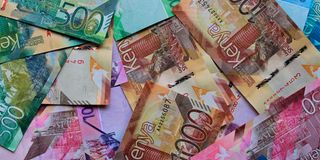Shilling’s strange behaviour calls for explanation

Kenyan currency notes.
What you need to know:
- In 1995, the shillings appreciated against the dollar — from 82 to 74 units — despite an underperforming economy.
- Not a steep increase, as it happened over three months, but with no visible economic activity to explain it, that startled experts.
It has been a dramatic time for the shilling. A few weeks ago, it was threatening to drop to its lowest as the dollar recorded a meteoric rise in recorded history.
Kenyans and the international community, losers and winners alike, sat on the edge and watched as the situation got more interesting.
Ordinary Kenyans watched in fear. Economic commentators, politicians and the National Treasury churned out even more confusing explanations.
They had different diagnoses. It was even more confusing when the shilling jumped out of its hospital bed. Is the recovery short-lived?
Kenyans need an urgent simplified fiscal education on the state of the shilling and its strange behaviour.
But first, let us go down memory lane.
In 1995, the shillings appreciated against the dollar — from 82 to 74 units — despite an underperforming economy.
Exchange rate
Not a steep increase, as it happened over three months, but with no visible economic activity to explain it, that startled experts.
Prime Cabinet Secretary Musalia Mudavadi, then the Finance minister, called a presser, at which he tried to link the shilling’s appreciation to increased exports in coffee and tea.
The journalists disputed that, as data from his ministry showed the contrary. His Cabinet colleague, Joseph Kamotho, came to his rescue in a rather vulgar manner. In his abrasive style, he called the journalists agents of the Opposition who did not wish Kenya well. End of presser.
The next day, opposition leaders Mwai Kibaki — who later became President — and current Kisumu County Governor of Anyang’ Nyong’o called a press conference. Prof Nyong’o attributed the situation to humanitarian activities in Rwanda.
Since the UN had set up base in Kenya for humanitarian efforts, the dollar was being used to buy basic necessities locally. Mr Kibaki said the exchange rate would go back to normal after the mission ended.
I watched the two interviews and, in my naivety, wondered why the government was causing unnecessary anxiety over the shilling.
Interestingly, a few days later, at a state function, Mudavadi repeated what Kibaki and Prof Nyong’o had told the media. The dollar settled at Sh80 after three months, occasionally gaining and losing a few shillings.
Diaspora confidence
A similar scenario played out when Narc took power in 2003. By June, the shilling started gaining steadily over the dollar.
Having opened the year at Sh80 to the greenback, it was trading at Sh71 and threatening to go below Sh70. This was under President Kibaki with Prof Nyong’o his Economic Planning minister.
Prof Nyong’o was again called upon to explain the trend and he attributed the shilling gains to investors’ and diaspora confidence in the new government, donor fund for free primary education and general goodwill from Kenya’s friends.
In the two previous cases, the shilling gained against the dollar by less than Sh10 over months. But now, it jumped Sh20 in a week.
What economic activity had triggered this strength in the shilling? The shilling’s loss over the dollar was gradual; could this be attributed to low exports versus high imports? Is everything okay with our currency?
Mr Opiyo is a political and public affairs analyst. [email protected]





